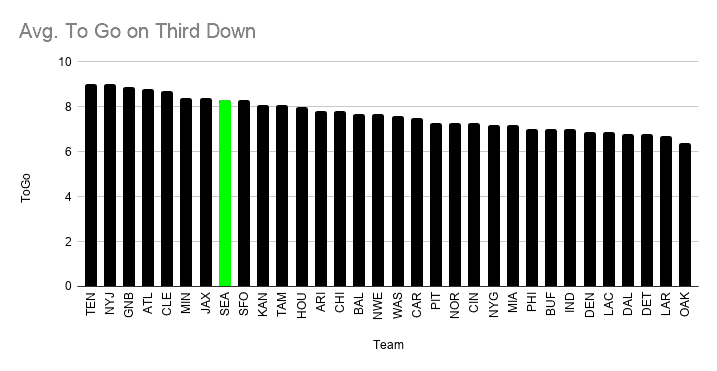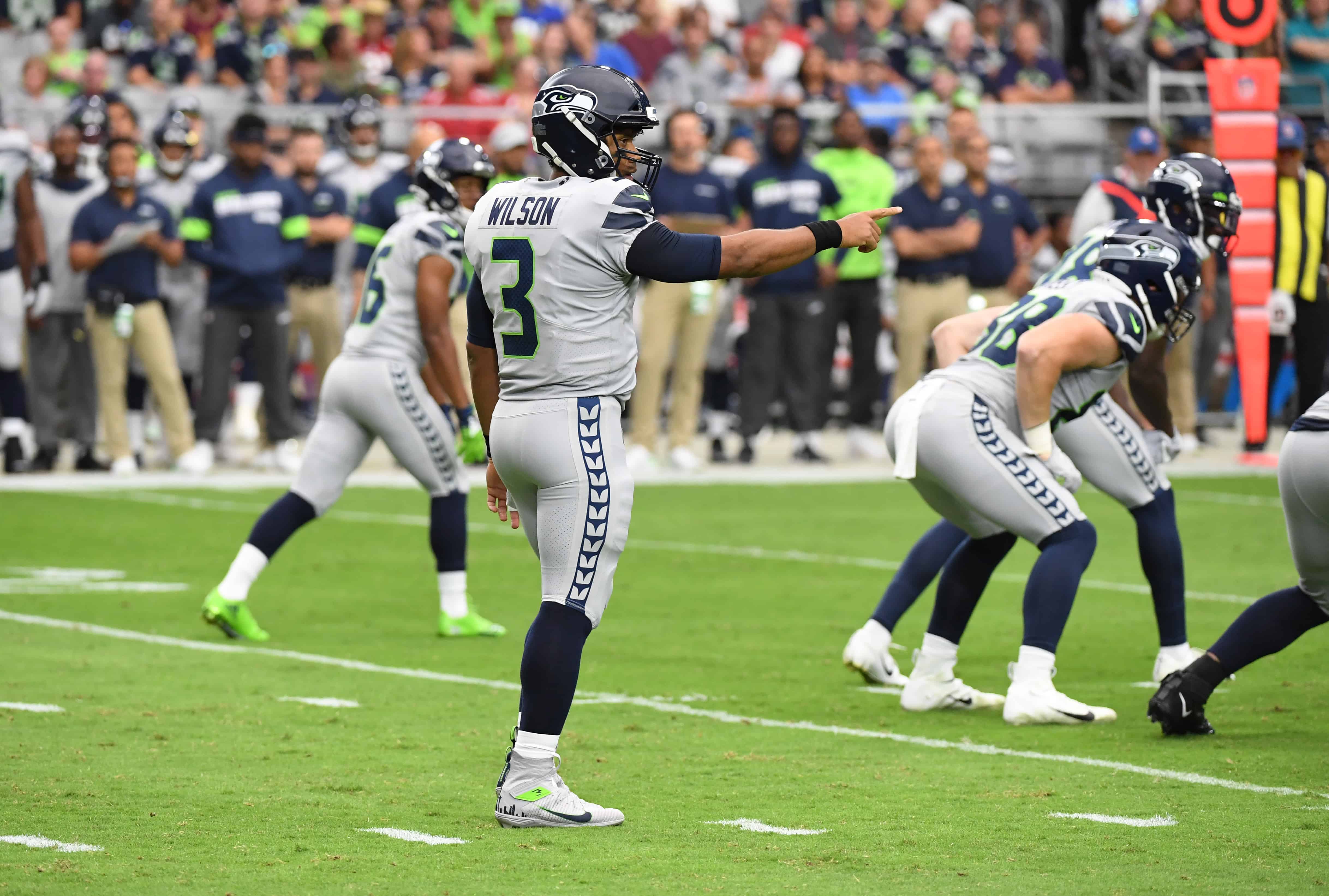Few football experiences are more entertaining than watching Russell Wilson. There are also few football experiences more perplexing than watching the Seattle Seahawks offense.
Over the past few seasons, Wilson has proven himself to be a truly special quarterback but the Seahawks often treat his talent as a “break glass in case of emergency” last resort than something they can use to their advantage on a regular basis. In a way, it’s made the process of watching Wilson more compelling, but also more infuriating at the same time.
Wilson has shed whatever game manager label he might have (incorrectly) held during the Marshawn Lynch and Legion of Boom years in Seattle and he’s cemented himself as one of the league’s best quarterbacks. Last year he carried a team some believed would be among the worst in the league to a 10-6 record and a playoff appearance. This year, he’s on his way to repeating that feat but better. The Seahawks are 4-1, Wilson is among the MVP favorites, and he might be playing the best football of his career.
Fighting the establishment
Part of what’s made Wilson so great, especially over the past year and a half, is the amount of weight put on his shoulders. Wilson is part of a team that strongly believes in establishing the run and has done so to its own detriment.
Per Football Outsiders, the Seahawks are first in DVOA on first down passes, but just 27th on first down runs. Still, the Seahawks pass just 47% of the time on first down. The disconnect between what the offense does well and what the offense wants to do goes deeper than that.
Seattle is one of the most run-heavy teams in the league on first and second downs in 2019. The Seahawks have thrown the ball just 48% of the time on those downs, well below the league average of 54%. It’s the seventh-lowest passing rate in the league.
All this comes despite Seattle’s success through the air on early downs. Seattle averages 9.0 yards per attempt throwing the ball on first and second down, the fifth-highest average in the league, with a 57% success rate. Only the Dallas Cowboys have both a higher yards per attempt average (9.5) and success rate (57%) on early downs.
The split becomes even more pronounced on early downs in the first half, when the run-pass split can be more attributed to the game plan than in the second half when the score of the game takes more control of play-calling tendencies. On first and second down in the first half, the Seahawks have thrown the ball just 48% of the time, which is the third-lowest in the league and well below the average rate of 56%. On those pass plays, Seattle averages 10.1 yards per attempt and a 54% success rate. Both numbers match those of the Kansas City Chiefs, who lead the league in pass rate at 73% on first and second downs in the first half.
It would be one thing if the Seahawks were one of the league’s best running teams, such as the San Francisco 49ers, who have the league’s lowest pass rate overall but still throw at a near-league average rate in the first half and have a well-designed run game that has been proven to work. Seattle, meanwhile, is 30th in Expected Points Added per attempt on early down runs in the first half, per Sports Info Solutions.
Those early down rushing attempts typically leave Seattle at a disadvantage on third downs. Through five weeks, the Seahawks have averaged over 8.0 yards to go on third down.
 Only the Texans, Cowboys, and Falcons average more yards gained than the Seahawks on third down (7.8 yards), but Seattle only ranks 21st in third down conversion rate. But thanks to Wilson, the Seahawks are fifth in DVOA on third and long.
Only the Texans, Cowboys, and Falcons average more yards gained than the Seahawks on third down (7.8 yards), but Seattle only ranks 21st in third down conversion rate. But thanks to Wilson, the Seahawks are fifth in DVOA on third and long.
Creating Structure
Within the passing game, Wilson has been a master of whatever has been put in front of him. There is some criticism of him as a passer that he is mainly an out of structure creator and he’d crumble in a more traditional drop back passing offense. I couldn’t think of criticism more off-base and devoid of reality.
So much of what Wilson has done has come off short drops within the structure of the Seattle offense. Per SIS charting, no quarterback has more attempts this season off 0/1-step drops. Now for Wilson, most of those attempts come in shotgun without Wilson needing to drop back any deeper. But even so, Wilson has been incredibly productive on those shorter drops. The average EPA per attempt on passe this season is 0.05. Wilson blows by that on everything but 5-step drops, which he has rarely been asked to do.
| Drop Type | Attempts | EPA | EPA/Att | Positive Play% |
|---|---|---|---|---|
| 0/1 | 76 | 19.8 | 0.26 | 59.3% |
| 3 | 24 | 7.7 | 0.32 | 53.6% |
| 5 | 9 | -3.4 | -0.38 | 27.3% |
| 7 | 6 | 6.1 | 1.01 | 83.3% |
data per Sports Info Solutions
The relatively short drops are just as much about allowing Wilson to get in a rhythm in the passing game as they are about not initially pushing Wilson too deep in a pocket with poor tackle play. Wilson can create some pressure on his own, but the offensive line play hasn’t been great around him. Per ESPN’s Pass Block Win Rate, Duane Brown is 30th among 66 qualified tackles and Germain Ifedi ranks 46th.
What really makes some of those short drops so impressive, especially given how they work to reduce pressure, is how often Wilson and the Seahawks are able to still go deep off of them. Wilson has seven attempts that have traveled at least 20 yards in the air off a 0/1-step drop. The next highest is three from Dak Prescott.
When Wilson has time, he can rip an accurate ball down the field better than any quarterback in the league, as he did here on a 28-yard touchdown pass to DK Metcalf in Week 2.
Then there are plays that start as quick drops then turn into Wilson creating a play on his own. Take this play at the end of the third quarter from the Week 5 game against the Los Angeles Rams. It was 3rd and 7 near midfield with Seattle down by five. The Seahawks went empty from 11 personnel with Rashaad Penny wide to the ride. The pocket started to collapse almost immediately, Wilson shuffled to his right, flung the ball downfield with a defender in his face, and hit Penny for a 30-yard gain.
This was a play where Wilson had to create on his own, but still did so within the structure of the play. Everyone involved on the offensive side of the ball would have preferred Wilson had the opportunity to make that throw from the pocket, but it wasn’t an option and Wilson either had to create that throwing lane on his own or take a loss.
Of course, there’s also no quarterback better at creating big plays down the field when he has to leave the pocket. Wilson has the most deep attempts (20-plus air yards) when not in the pocket this season (eight), just one above Patrick Mahomes. On those throws, he’s averaged over 2.0 EPA per attempt (2.11) with a positive play rate of 87.5%. The next best in each category is Mahomes with 1.6 EPA per attempt and a positive play rate of 71.4%, per SIS.
Degree of Difficulty
There’s not a lot to suggest Wilson is in a quarterback friendly environment. There’s no revered play-designer or a pass-heavy game plan that makes the most of Wilson’s ability to throw. Wilson has overcome those obstacles and has also beaten expectations on the throws he does make.
38 quarterbacks qualify for Next Gen Stats’ passing leaderboard in 2019. Of those quarterbacks, Wilson has the 10th-lowest Expected Completion Percentage (62.5%), which uses tracking data to map the distance of the throw, how far away the receiver is from a defender and the sideline, then uses that to produce a probability of a completion on each throw. In reality, Wilson is third among those quarterbacks in actual completion percentage at 73.1%, just behind Chase Daniel and Derek Carr at 73.3%. Wilson’s 10.5% gap leads the league. In the previous three seasons Next Gen Stats has tracked this metric, no quarterback has come close to a 10% above expectation rate over the course of a full season. The closest was Kirk Cousins in 2016 at 8.4%. The previous leaders over the past two seasons were both Drew Brees at 3.5% and 6.9%.
Wilson is doing this by completing spectacular throws, like the 13-yard touchdown pass to Tyler Lockett in Week 5, that had the lowest completion probability (6.3%) Next Gen Stats has tracked since the 2017 season.
It’s not as if Wilson is just completing these unbelievable throws at a high rate. He only has one other throw among the 20 most unlikely completions of the season, a 54-yard pass to Metcalf against the New Orleans Saints.
Instead, Wilson is just making really good throws all the time. As ESPN’s Bill Barnwell has noted, no quarterback has made more deep tight window throws over the past three-plus seasons.
The NFL’s Next-Gen Stats created a metric called Dimes, which is for throws traveling 30 or more yards in the air into windows of one yard or less. The top five since 2016:
Russell Wilson, 40
Matthew Stafford, 34
Ben Roethlisberger ,33
Dak Prescott, 28
Drew Brees, 28— Bill Barnwell (@billbarnwell) October 10, 2019
We’ve talked about the dangers of throwing into tight windows at a high rate and how the best quarterbacks and offenses are avoiding them. What makes Wilson so special right now, is he still is avoiding them for the most part. He’s only thrown 14.7% of his attempts into tight windows this season, which is the 16th-lowest rate among quarterbacks. But when he has fired into those windows, he’s hitting them. It’s not a forced situation, it’s a calculated risk.
Seattle has too often put Wilson in situations where he has to take those types of risks, but there might not be a better quarterback equipt to handle them. With Wilson under center, the Seahawks are going to remain playoff contenders, despite the rest of the league’s or Seattle’s own efforts.
















